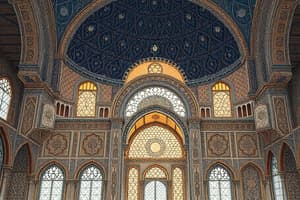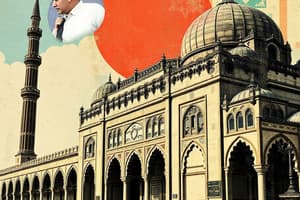Podcast
Questions and Answers
What is the purpose of the Mihrab in a mosque?
What is the purpose of the Mihrab in a mosque?
- To indicate the direction of the Kaaba in Mecca (correct)
- To serve as a pulpit for the Imam
- To indicate the direction of the Minbar
- To symbolize the unity among Muslims
What is a characteristic feature of Arabesque ornamentation?
What is a characteristic feature of Arabesque ornamentation?
- Use of bright colors and metallic paint
- Use of figurative motifs
- Depiction of Islamic historical events
- Intricate geometric patterns and arabesques (correct)
What architectural innovation emerged during the Middle Islamic Period?
What architectural innovation emerged during the Middle Islamic Period?
- The introduction of the four-iwan plan (correct)
- The development of the hypostyle mosque
- The construction of minarets
- The use of domes and half-domes
How did Islamic art influence Western art and architecture?
How did Islamic art influence Western art and architecture?
What does the Mosque represent in Islamic culture?
What does the Mosque represent in Islamic culture?
What is one of the techniques used in Arabesque ornamentation?
What is one of the techniques used in Arabesque ornamentation?
Flashcards are hidden until you start studying
Study Notes
Mosque Design
- Key features:
- Mihrab (prayer niche) indicating the direction of the Kaaba in Mecca
- Minbar (pulpit) for the Imam to deliver sermons
- Minaret (tower) for the call to prayer
- Hypostyle halls with columns and arches
- Types of mosques:
- Masjid (congregational mosque)
- Masalla (prayer hall)
- Jami Masjid (Friday mosque)
Arabesque Ornamentation
- Characterized by:
- Intricate geometric patterns and arabesques
- Floral motifs, foliage, and vines
- Use of calligraphy and geometric shapes
- Techniques:
- Glazed tilework (zellij)
- Carved stucco and stone
- Painted decoration
- Symbolism:
- Geometric patterns represent the infinite and the divine
- Floral motifs symbolize paradise and the garden of Eden
Architectural Evolution
- Early Islamic Period (7th-10th centuries):
- Influence of Byzantine and Sassanian styles
- Development of the hypostyle mosque
- Middle Islamic Period (11th-13th centuries):
- Introduction of the four-iwan plan
- Development of madrasas (Islamic schools)
- Late Islamic Period (14th-16th centuries):
- Ottoman and Mughal styles emerge
- Increased use of domes and half-domes
Influence of Islamic Art
- On architecture:
- Use of arches, domes, and minarets
- Incorporation of Islamic calligraphy and geometric patterns
- On art and craft:
- Development of ceramics, textiles, and metalwork
- Influence on Western art and architecture (e.g., Gothic cathedrals)
Cultural Significance
- Representation of Islamic values and beliefs
- Symbol of community and unity among Muslims
- Expression of cultural and artistic excellence
- Preservation of Islamic heritage and tradition
Mosque Design
- A mosque's key features include: Mihrab (prayer niche) indicating the direction of the Kaaba in Mecca, Minbar (pulpit) for the Imam to deliver sermons, Minaret (tower) for the call to prayer, and Hypostyle halls with columns and arches
- There are different types of mosques: Masjid (congregational mosque), Masalla (prayer hall), and Jami Masjid (Friday mosque)
Arabesque Ornamentation
- Arabesque ornamentation is characterized by intricate geometric patterns and arabesques, floral motifs, foliage, and vines, and the use of calligraphy and geometric shapes
- Techniques used in arabesque ornamentation include glazed tilework (zellij), carved stucco and stone, and painted decoration
- Geometric patterns represent the infinite and the divine, while floral motifs symbolize paradise and the garden of Eden
Architectural Evolution
- During the Early Islamic Period (7th-10th centuries), mosque architecture was influenced by Byzantine and Sassanian styles, and the hypostyle mosque developed
- In the Middle Islamic Period (11th-13th centuries), the four-iwan plan was introduced, and madrasas (Islamic schools) were developed
- During the Late Islamic Period (14th-16th centuries), Ottoman and Mughal styles emerged, and the use of domes and half-domes increased
Influence of Islamic Art
- Islamic art influenced architecture through the use of arches, domes, and minarets, and the incorporation of Islamic calligraphy and geometric patterns
- Islamic art also influenced ceramics, textiles, and metalwork, and had an impact on Western art and architecture, such as in Gothic cathedrals
Cultural Significance
- Mosques represent Islamic values and beliefs, and symbolize community and unity among Muslims
- Mosques are an expression of cultural and artistic excellence, and preserve Islamic heritage and tradition
Studying That Suits You
Use AI to generate personalized quizzes and flashcards to suit your learning preferences.




